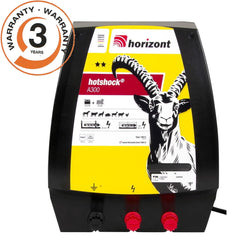You have no items in your shopping cart.
Essentially the quick answer is to use mains if you possibly can.
Mains Energiser – This is much the preferred option, mains power is reliable, cheaper to run  and less hassle than battery powered systems. These energisers are typically able to handle longer fences and difficult to control animals. It is this simple: plug your energiser into the standard mains socket, the energiser converts the power and the resulting pulse is taken out to your fence through a high volt cable.. This cable should be considered in your total fence length calculations and may be as far as 500 meters from the energiser. High Volt cable comes in two diameters - 1.6mm core in 25m, 50m and 100m lengths and 2.5mm core in 100m lengths. These may be joined together with a waterproof join to achieve greater lengths.
and less hassle than battery powered systems. These energisers are typically able to handle longer fences and difficult to control animals. It is this simple: plug your energiser into the standard mains socket, the energiser converts the power and the resulting pulse is taken out to your fence through a high volt cable.. This cable should be considered in your total fence length calculations and may be as far as 500 meters from the energiser. High Volt cable comes in two diameters - 1.6mm core in 25m, 50m and 100m lengths and 2.5mm core in 100m lengths. These may be joined together with a waterproof join to achieve greater lengths.
Battery Energiser – Your electric fence may be too far away from the mains and so battery power is the only option. Energisers can be powered by different batteries:

- Torch D-Cell or 6v lantern type battery powered energiser for small distances, strip grazing, gardens and pond protection (up to 400m). These may be either throw away or rechargeable.
- 9 Volt battery Energiser – very portable, light-weight, easy to use. Mid range energisers usually up to a maximum of 1800m of wire. These are housed within the energiser making them very light, compact and easy to transport. These are disposable batteries – non re-chargeable but come in a range of capacities, 55 - 200 ampHour so have an excellent lifespan.
- 12 Volt – Re-chargeable battery Energiser. Although a car battery will work it is preferable to use a leisure battery and not a car battery. (Here is an Explanation WHY these are better.) Car batteries are designed to release power quickly with an immediate recharge. They are also generally only 25 ampHour so on a fence will need regular recharging.
Leisure or Deep Drawdown batteries are designed for a slow release and as they come in far higher capacities (80- 200 ampHours) will require less regular recharging. (Depending on the energiser - may last over 1000hours.)
Dual powered energiser – These energisers can work off mains or battery. These energisers will come with all the accessories you need to run either system. Very versatile and handy.
Solar Assist Energisers. - For the more remote or the environmentally aware customer there is  also a solar powered energiser option saving the chore of constantly charging batteries and ensures constant supply of power to the fence. Studies have been made to establish which is the optimum panel capacity to run specific energisers. The conclusion is that a 20 watt monocrystalline solar panel is needed to ensure that a 2 joule fencer battery is kept fully charged and functional throughout the majority of weather conditions - including Winter. Below that a 10 watt panel will be adequate. There are units available that have only a 2watt panel - these will be fine in summer but have very little benefit during the winter.
also a solar powered energiser option saving the chore of constantly charging batteries and ensures constant supply of power to the fence. Studies have been made to establish which is the optimum panel capacity to run specific energisers. The conclusion is that a 20 watt monocrystalline solar panel is needed to ensure that a 2 joule fencer battery is kept fully charged and functional throughout the majority of weather conditions - including Winter. Below that a 10 watt panel will be adequate. There are units available that have only a 2watt panel - these will be fine in summer but have very little benefit during the winter.
A 12v Battey is still required, with a solar panel constantly recharging your 12volt battery it is now feasible to leave your energiser for extended periods with no maintenance.
It is possible to boost the output of a solar panel.
All energisers must comply with the European Standard EN 60335- 2-76. They should also comply with European Directive (EMC) 89/336/EEC) and are printed with the CE mark.








← Older Post Newer Post →
2 comments
You need to purchase an energiser suitable for your requirements – The battery CANNOT run a fence on its own.
How do I get the electric fence Energizer?